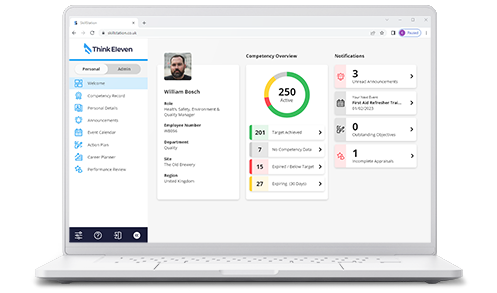Health and Safety for Managers eLearning Course
Overview
This RoSPA-accredited, level-3, e-learning course is suitable for anyone with health and safety responsibility within an organisation. The course includes optional voiceover recorded by a professional actor.
It is specifically designed to teach learners everything from the basics of health and safety management, writing a policy, conducting risk assessments, training, first aid provision and reporting incidents (RIDDOR).
Law & Legislation
This course covers key points from:
- The Control of Substances Hazardous to Health Regulations 2002
- The Health and Safety at Work Act 1974
- The Work at Height Regulations 2005
- The Personal Protective Equipment at Work Regulations 2002
- The Personal Protective Equipment at Work Regulations 1992
- The Manual Handling Operations Regulations 1992
Course Content
- Rights and Responsibilities - A basic introduction to an employee's health and safety responsibilities, how health and safety is managed in the workplace, the importance of risk management.
- Understanding Risk Assessments - The principles of risk assessment, the definition of "hazard" and "risk", the 5-step approach to risk assessment
- Hazards - The most common workplace hazards and how risks can be controlled, including: lighting, temperature, ventilation, noise, machinery and equipment.
- Slips, Trips and Falls - The most common causes of slips, trips and falls, and what can be done to prevent incidents.
- Manual Handling - The hazards associated with manual handling operations, manual handling law, an introduction to how a manual handling risk assessment is conducted, the basic principles of good handling technique.
- Working at Height - Activities that are considered work at height, how to reduce risk when working at height.
- COSHH - An introduction to the Control of Substances Hazardous to Health, common hazardous substances, how to reduce risk when working with hazardous substances, understanding labels and data sheets.
- PPE - Understanding how and why personal protective equipment is used, some common examples of PPE, the use of PPE including: training and maintenance.
- Display Screen Equipment - Understanding what is covered by a display screen equipment (DSE) risk assessment, how to reduce risk when working with DSE.
- Fire - What can cause fires, how to reduce the risk of harm from fire including preventing and controlling fire, an introduction to fire extinguishers.
- Electrical Safety - How electricity can cause harm, how to reduce risk when working with electricity.
- Environmental Health and Safety - What is covered when talking about the environment in a health and safety context, environmental legislation, what actions can be taken to reduce environmental impact.
- Driving Safety - Understanding what road-related activity is covered by health and safety law, the road-safety checklist for reducing risks associated with driving at work.
- Stress Awareness - Understanding stress and what causes it, how to reduce the risk of harm caused by stress, how to spot the signs of stress, mental health and how it relates to stress.
- In The Event of an Incident - What to do in the event of an incident, the accident book, and accident investigation.
- Introduction for Employers and Managers - Your key responsibilities – writing a health & safety policy, risk assessments and legal requirements.
- Plan, Do, Check Act - A simple breakdown and step by step guide to this recommended approach.
- Writing a Policy - A simple step by step guide to writing a health & safety policy for your organisation; includes an easy-to-complete template.
- Performing a Risk Assessment - Controlling risks, the overall process, a straightforward guide to carrying out and recording your risk assessment.
- Training - Training people in health & safety - your legal obligations, specific training needs, who needs to be trained, HSE five-step approach to health & safety training.
- First Aid Provision - Your requirements under the Health & Safety (First-Aid) Regulations 1981; assessing your needs, guidance on first aid boxes, trained first-aiders, accident books.
- Reporting Incidents - RIDDOR - Reporting of Injuries, Diseases and Dangerous Occurrences Regulations – specific guidance on what you need to report, dangerous occurrences, how to file your report.
This course has a minimum of 25 learner registrations for us to provide a quotation.
Request a Quotation- Language
- UK
- Date last updated
- 11/6/2023
- Duration
- 3 Hours 50 Minutes
- Suitable Devices
-
- PC
- Phone
- Tablet
- Audio is Required
-
- Optional
- Includes Video
-
- No
- Downloadable Resources
-
- No
- Completion Criteria
-
- Complete all modules
- Pass final test
- Visit all pages
- Pass Mark
-
- 75% pass mark required
- Course Technology
-
- HTML5
- SCORM 1.2
- Can be customised
-
- Available at an Additional Cost
- Accreditation or Endorsements
-
- CPD
- ROSPA
- Languages
-
- English
